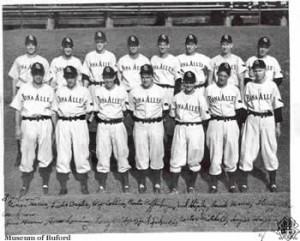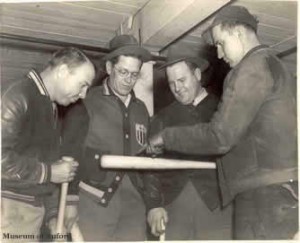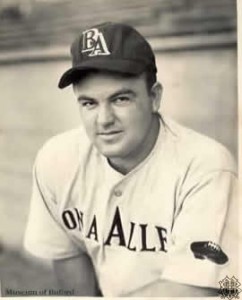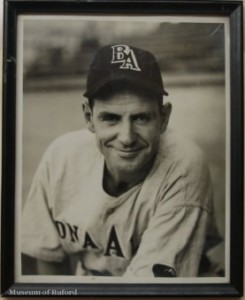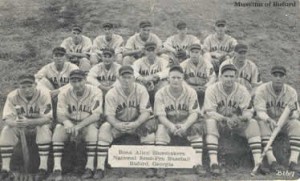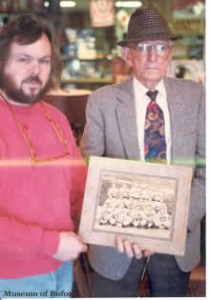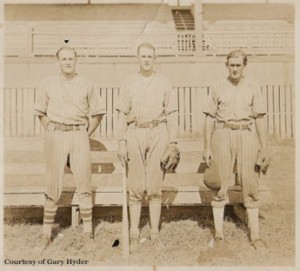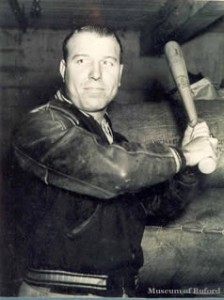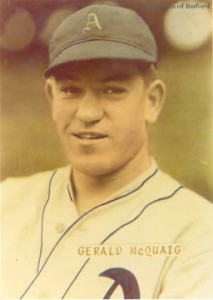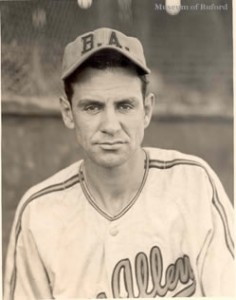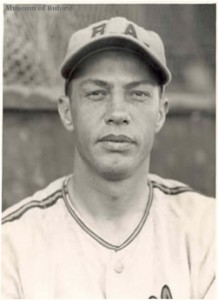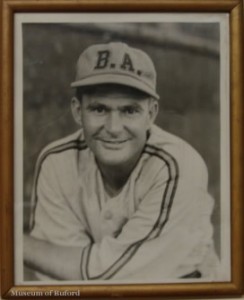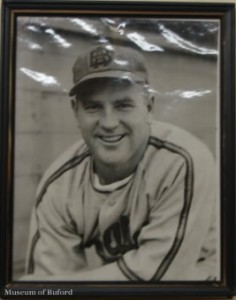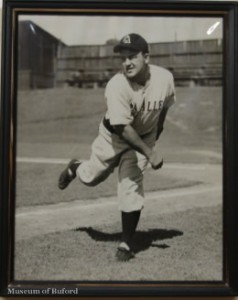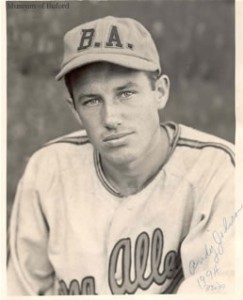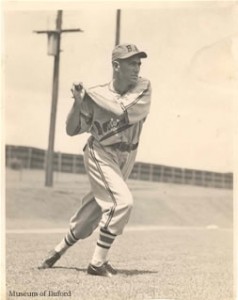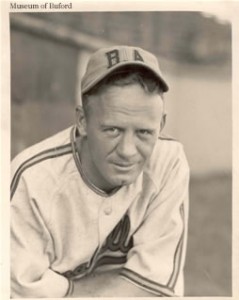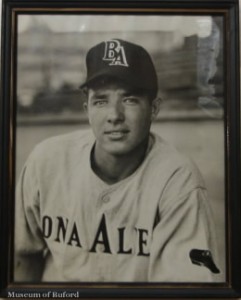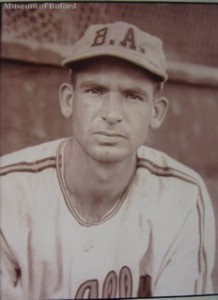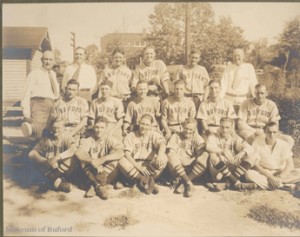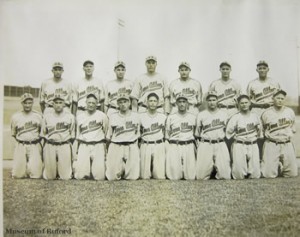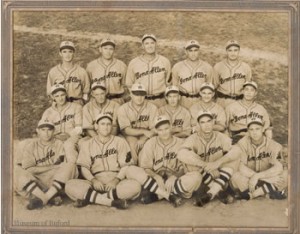As the rest of the nation stumbled through the Depression era, a small fiefdom flourished in the Land of Dixie – not because of King Cotton, but because of leather shoes and baseball.
Building Big Baseball in Small Towns
In the 1930s, the scope of semi-pro baseball grew to enormous proportions as factories and mills across the country sponsored teams in order to advertise and promote their businesses. Additionally, the ball teams provided
affordable entertainment and a
source of civic interest and pride for
the local fans. Major league baseball
had only 16 teams, none farther south
or west than Saint Louis. The minor
leagues extended baseball’s reach a
bit but remained somewhat limited
because the concept of the farm
system had not yet fully matured.
Therefore, semi-pro baseball teams
enjoyed immense regional, and
sometimes even national, popularity.
A factory town in Georgia was home
to one of the finest semi-pro teams in
history. Located about 40 miles
northeast of Atlanta on a main rail
line, Buford thrived as the largest
municipality in Gwinnett County at
that time. Billed as “Depression-
proof,” the town owed its prosperity
to the savvy operations of Bona Allen,
Inc. The leather company’s policy of
not selling stock or borrowing money
not only kept the townspeople out of
the unemployment line but allowed the company to expand its already bountiful business during a time when many other factories filed for bankruptcy. Bona Allen, Inc. reached its peak employment (more than 2,200 workers) and production (more than 3,000 pairs of shoes per day) in 1932.1
However, not all of the leather went into making shoes. The nation’s largest tannery had a contract to supply the sporting equipment giant, Spalding, with raw material for the manufacture of baseballs and baseball mitts.2 One of Bona Allen’s sons, John Q. Allen, recognized the publicity potential of the situation. Spurred on by his passion for baseball, Mr. Allen arranged for his company to field a semi-pro baseball team in 1933. The Bona Allen Shoemakers, as they were called, mirrored the good fortune their sponsoring company, and the ball club enjoyed immediate success: The 1933 team won 56 of its 61 games.3
The prosperity of the leather company and the winning ways of its Shoemakers helped each to benefit from the other. Mr. Allen attracted former major leaguers and up-and-coming college players to the team with promises of good salaries and good baseball. Being employees of Bona Allen, Inc., these men welcomed the prospect of having winter jobs in addition to being paid to play baseball for seven months out of the year. The standard minor league season ran for only five months, so two extra months pay at $300-$400 per month beckoned as a large incentive at a time when a pair of shoes cost five dollars.4
Gimmicks and Games
John Q. Allen masterfully blended the marketing and baseball aspects of the company and the team into clever promotions revolving around shoes. Mr. Allen ordered the construction of the “World’s Largest Shoe on Wheels,” a huge replica of the company’s best-selling shoe mounted the chassis of a Chevrolet. A publicity man would drive the Shoe Car through the town, passing out leather key chains and announcing the arrival of the baseball team.5 Each time a Shoemaker hit a home run, that player would be rewarded with a coupon for a free pair of shoes. Alternatively, two coupons could be cashed in for a pair of boots – a luxury in those lean years. When the Shoemakers threw a shutout, the pitcher, catcher, and manager would each receive coupons. The Bona Allen company increased the challenge and brought added attention to the games by loudly promising a free pair of their Victor-5’s to each member of any team that could defeat his Shoemakers.6
Most opposing players shuffled home in their old shoes. The Bona Allens maintained their first-year success, capping off the 1934 season by winning two of three ball games from the highly-regarded Atlanta Crackers of the Southern Association7 – a Double A league (which was the highest minor league classification at the time).
In 1936, the Shoemakers rode a 35-game winning streak to a 73-6 record and an invitation to the National Baseball Congress World Series in Wichita, Kansas.8 (Each year since 1935, the National Baseball Congress has gathered together the top-ranked semi-pro baseball teams in the country for a tournament to determine the best team in the nation.9) The Shoemakers brought the runner-up trophy back to Buford, stopping off first in Atlanta to take a pair of post-season contests from the Crackers.10
Backed by the rich oil-producing companies, the team from Enid, Oklahoma, took top honors at the National Baseball Congress World Series in 1937, again sending the Bona Allen team home with the second place cup.11
The next summer found the Bona Allen team facing rival Enid, Oklahoma in a rematch of the previous year’s National Baseball Congress World Series finals. The two teams had met earlier in the year at the Denver Post invitational tournament finals – a battle which had been won by Enid.12 Undaunted, the boys from Buford prevailed in Wichita and were awarded $5,000 in prize money and the title of 1938 Semi-pro World Series Champions.
The Shoemakers gained more national recognition (and money) in 1940 when they won the distinguished Denver Post tournament by beating the reigning national semi-pro champions from Duncan, Oklahoma. Along with the championship came $5,238 in prize money.13
John Q. Allen had an arrangement with his ball club regarding trophies and prize money: Mr. Allen retained possession of each trophy, and the players kept all of the prize money to split among themselves14 – an arrangement viewed as more-than-fair by the team!
Hometown Field, Hometown Fans
The winning team quickly created a loyal following, and the Bona Allen company responded by building one of the finest ball parks in the Southeast. The players claimed the condition of the field to be better than that of Ponce De Leon Park, home of the rival Double A Atlanta Crackers15.
Buford hosted the first night game in Georgia north of Atlanta on June 8, 1937. More than 2,500 Shoemaker faithful crowded into the park to watch their local heroes rumble to a 16-0 win.16
Even the out-of-town tournament games provided special excitement for the “spectators” back home. According to Hansel Grady Morgan’s book, “Historic Buford”:
“Play-by-play accounts of [the] tournament games were received at the Bona Allen office by teletype and ‘broadcast’ by loudspeaker to an eager crowd assembled [at] … the ball park. ‘It was just like any other game. The concession stands were open and several hundred people would sit, staring at an empty field, listening to a ball game being played 1000 miles or more away.'”17
Player Profiles
The two surviving members of the 1938 Championship team represent the two types of players which made up semi-pro teams of the era.
Georgia-born Gerald McQuaig had played in a handful of games for the 1934 Philadelphia Athletics18, but with eyesight poor enough to require glasses, he was slightly overmatched by big league pitching. John Q. Allen realized McQuaig’s power potential and convinced the center fielder to play for the Bona Allen team.
The former major leaguer proved instrumental in many of the Shoemakers’ wins and made such an impact that the National Baseball Congress inducted Gerald McQuaig into its Hall of Fame in 1944. However, McQuaig contributed more than his many home runs – he became one of Buford’s leading citizens. After his career with the Shoemakers, McQuaig coached baseball at Buford City High School and served as principal at nearby Sugar Hill Elementary School.19
McQuaig and his wife still reside in Buford.
Another Georgia native arrived in Buford via a different path. Andy Johnson grew up near Conyers, Georgia, and played on the local town team while in high school. Looking for a scholarship to attend college and play baseball, Johnson hopped a bus and showed up unannounced at the door of the baseball coach for Oglethorpe College in Atlanta. An exhibition game had already been scheduled against the Bona Allen Shoemakers later that week, so the coach invited Johnson to play in the game as a tryout. Johnson responded with three base hits against the vaunted Shoemaker pitching staff. John Q. Allen tucked away the memory of this hitting performance, and upon Johnson’s graduation from Oglethorpe College four years (and a .365 batting average) later, tried to recruit Johnson to join the Buford nine. Already committed to play on a Coastal Plain League team in Greenville, North Carolina, Johnson took Mr. Allen up on the offer the following year.20
In the two seasons that Andy Johnson played for the Bona Allen Shoemakers, he proved to be a major factor in the team’s winning of its only semi-pro championship. In the 1938 season, the first baseman batted .344 and committed no errors. Moreover, Johnson was named as the Most-Valuable Player in the National Baseball Congress World Series tournament. In 1939, Johnson hit .392 and committed only one error. At one point during the year, he needed four hits in his next four at-bats to reach a season mark of 100 hits in 200 at-bats. The left-handed hitter knocked four balls over a short right field wall (ground rule doubles in the small, Lynchburg, Virginia ballpark) and ended the day holding on to a .500 batting average!21
After spending a couple of seasons with the Double A club in Birmingham, Alabama, Johnson finished his semi-pro career playing ten seasons for the Norton Company in Worcester, Massachusetts. Afterwards he returned to Georgia and worked in sales.22
Andy Johnson married a former Buford elementary school teacher he met during his Shoemaker playing days. The Johnsons are currently enjoying retirement at their home in Conyers, Georgia.
All Good Things…
The involvement of the United States in World War II and movement toward the unionization of workers in 1941 marked the beginning of a decline for Bona Allen, Inc.23 and brought an end to the Buford baseball dynasty. In the team’s final season, the Bona Allen Shoemakers finished 7th in the National Baseball Congress World Series but finished as runner-up in the Denver Posttournament and won the Houston Post tournament.24
Eventually, Bona Allen, Inc. went out of business, and the surrounding city fell onto less prosperous times. In recent years, a growing artist community has rallied support to revitalize much of historic Buford. One downtown gallery houses the Museum of Main Street, which has on display pictures, articles, scorebooks, and trophies of the Bona Allen Shoemakers.
And, on the outskirts of the town, a pair of light posts still patrol the outfield over at the site of the old ball park.
Notes:
1 Will Anderson, “Gwinnett History: Shoe entrepreneurs left lasting legacy: ‘The Leather City’: Thanks in part to Bona Allen Inc., Buford was the county’s largest town for 60 years.,” The Atlanta Journal and Constitution, 2/1/1998, pp. J10.
2 J. P. Alexander’s interview with Andy Johnson, 4/5/2000.
3 Hansel Grady Morgan, Historic Buford, published by city of Buford, Georgia, 1993, Thomasson Printing Co., Inc., Carrollton, Georgia, p. 137.
4 Andy Johnson interview.
5 Linda Jacobsen, “Bona Fide Champs: Tannery team ruled semipros in ’38 season.,” The Atlanta Journal and Constitution, 10/23/1991, pp. J/01.
6 Andy Johnson interview.
7 Morgan, p. 137.
8 Ibid, pp. 137-138.
9 From the article “History of the NBC” on the National Baseball Congress Web site,http://www.wichitaeagle.com/NBC/
10 Morgan, p. 138.
11 “Buford Named as Outstanding Semi-pro Team: George Sisler Trophy awarded to Best U. S. Nine in 1936-37.,” The Atlanta Constitution, 5/17/1938.
12 Andy Johnson interview.
13 Rebecca McCarthy, “Baseball still a big hit with scout Mercer Harris: Game has been part of his life for over 60 years.,” The Atlanta Journal and Constitution, 5/18/1998, pp. J/01.
14 Ibid.
15 Jacobson, pp. J/01.
16 Morgan, pp. 138-9.
17 Morgan, pp. 139-140.
18 John Thorn and Pete Palmer, Total Baseball, Warner Books, Inc., New York, 1989, p. 1306.
19 Jacobson, pp. J/01.
20 Andy Johnson Interview
21 Ibid.
22 Ibid.
23 Anderson, pp. J10.
24 Andy Johnson Interview
Vol 1, No. 1 June 2000 issue of Baseball Ink. The booklet, which contains some historical photos, is available for purchase from the museum store.
Additional Shoemaker Information
The Bona Allen Shoemakers were a semi-pro industrial league baseball team sponsored by the Bona Allen Shoe Company. They were active during the late 1920’s through the early 1940’s when World War II began. Their most successful years were the late ’30s and early ’40s. They won the 1938 national semi-pro championship held in Wichita, Kansas, as well as the Denver Post Baseball Tournament championship in 1940.


